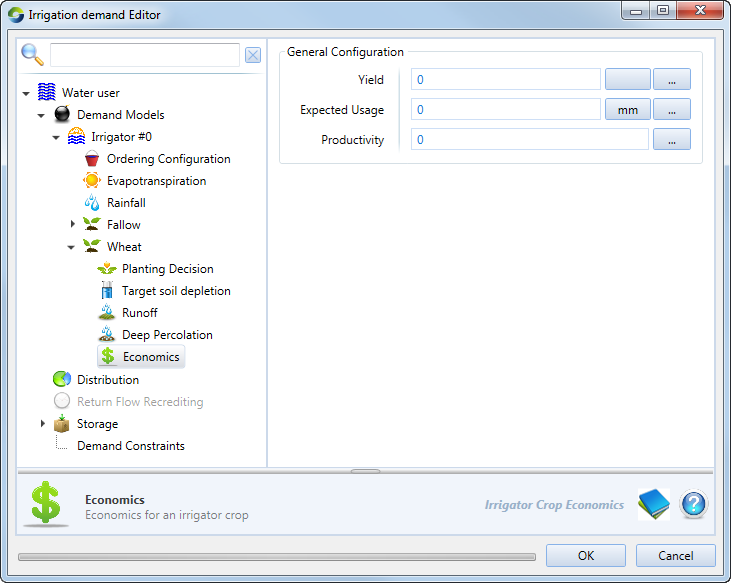Irrigator Demand Model
Meryl McKerrow
SysAdmin eWater
Analytics
Irrigator operates on a daily basis generating demands and extracting water to meet these demands via the water user and supply nodes. Irrigator maintains a daily water balance for each cropping area during its planting season, to calculate the daily soil water deficit and an irrigation requirement. The irrigation requirements are used by the Water User to generate orders and opportunistic requests and to subsequently place orders and requests and to extract water from a water source.The model can be applied in both regulated and unregulated systems.
Configuring generic crop settings
To configure an irrigator demand model in Source, right click Demand Models in the Water User node's feature editor and choose Add Irrigator.
District Configuration
This describes a number of parameters that can be set at an irrigation district level. The following parameters must be configured:
- Maximum irrigated area - this represents the maximum area that can be irrigated within a district. It is used to calculate the fallow area at each time-step, which impacts on the rainfall runoff from the fallow area. The total irrigated area can exceed the maximum irrigated area if incorrectly configured, causing a warning message to be recorded at run time;
- Soil moisture capacity - this is assumed constant for all crops in the district. Soil moisture capacity is nominally the difference between the soils field capacity and permanent wilting point;
- Irrigation start and end dates - if these are configured, orders and requests will only be generated within the irrigation season; and
- Demand Limiting Factor - allows you to limit any spikes in demand that may happen. Typically, these spikes would occur when a crop is first planted to reach the target moisture level. This is a factor of the time-step's evaporation depth. For example, if this has a value of 2, demand is limited to a maximum of twice the day's evaporation depth.
Figure 1. Irrigator demand model
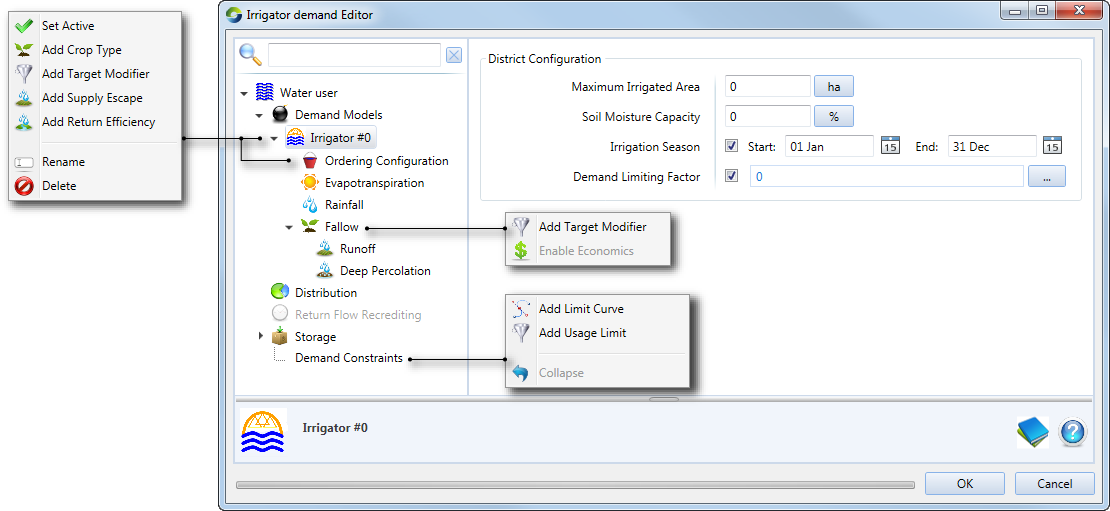
Target Modifier
Irrigation modifiers are included in Source to allow a simple mechanism to reduce irrigation intensity for recurring time periods. To enable a target modifier, right click on the demand model and choose Add Target Modifier (as shown in Figure 1). This provides equivalent functionality to demand reductions in the PRIDE model. By specifying a target modifier, a new soil depletion target is calculated during the specified period that results in a reduction in irrigation demand equivalent to the modifier you specified.
District Supply Escape
The district requirement is adjusted to allow for any district delivery supply escapes and losses associated with delivering water to the district. The volume removed before getting to the crop is called the escape volume. The escape volume can either be lost from the system or returned back to the water user as a return flow. This is an optional parameter in the demand model and can be added by right clicking Irrigator, then choosing Supply Escape. It is expressed as a percentage.
District Return Efficiency
Returned water is surplus drainage water from irrigation or from rainfall runoff. This water can be redirected into the on farm storage or otherwise can be returned to the river via a confluence node. This is optional in the demand model configuration and can be added by right clicking Irrigator and choosing Add Return Efficiency. This is also expressed as a percentage.
Ordering configuration
You can configure two climate parameters using the Ordering Configuration tree menu item:
- Average Evaporation is used when forecasting orders (shown in Figure 2). You can enter a daily pattern of average evaporaration, specify an expression, or select to calculate an average evaporation runtime over a specified number of time-steps; and
- Average Rainfall is used to specify the forecast average rainfall. Its configuration window is similar to the one for Average evaporation (Figure 2).
Figure 2. Irrigator demand model (Ordering configuration, Average evaporation)
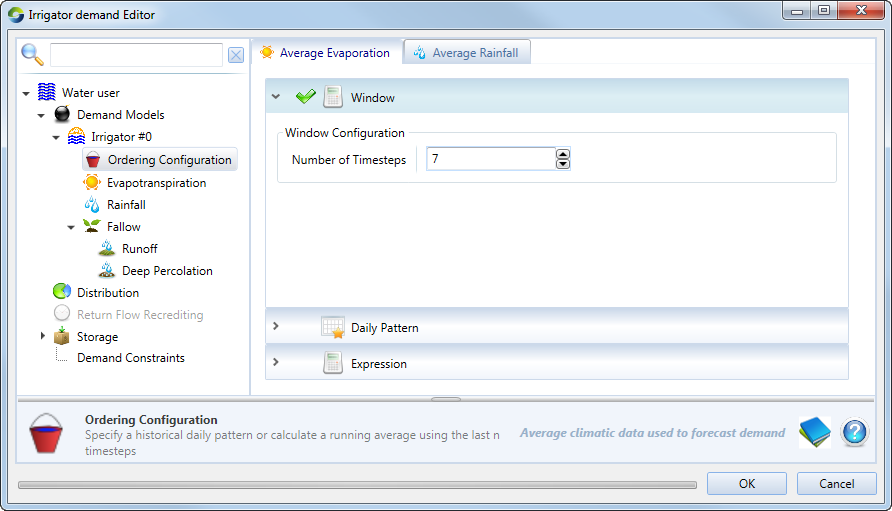
Climate Configuration
There are two parameters that can be defined for climatic data:
- Evapotranspiration (shown in Figure 3) - defined in FAO56 as the amount of transpiration that would occur from a reference crop. Procedures for calculating evapotranspiration are documented in FAO56. In addition, the BOM and SILO climate products produce daily estimates for FAO56. Alternatively, pan evapotranspiration and pan factors can be used to define evapotranspiration; and
- Rainfall - This can be specified as a constant value, a time series or a function. The configuration window is similar to that for Evapotranspiration (shown in Figure 3).
Figure 3. Irrigator demand model (Evapotranspiration)
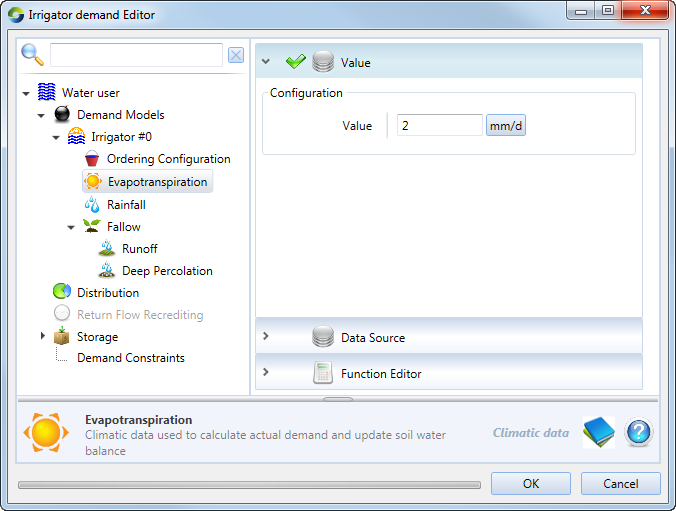
Fallow Crop
Areas that are not being cropped are referred to as fallow. Every irrigator demand model has, by default, one fallow area. Fallow area occurs between cropping seasons or during the irrigation season if the maximum developed area is not planted. The fallow cropping area does not order or receive irrigation water. However, a soil water balance of the fallow crop is maintained, and impacts on rainfall runoff from the fallow area and the initial soil moisture assigned to new crops area. The depth of rootzone for fallow represents the depth of soil from which evaporation can occur.
Crop Configuration
This is used to define parameters specifically related to the crop to be planted. To add a new crop, right click Irrigator and choose Add Crop Type. Figure 4 shows an example of a crop, named Wheat, that has been added to the model. Consult the Source Scientific Reference Guide for detail on the parameters for configuration.
Soil Configuration
Crop specific soil factors can be defined on the same page as General Configuration (see Figure 4). Soil moisture capacity is specified at the district level and this is assumed constant for all crops in the district. You must also specify Depth of the Root Zone, Depletion Factor and Initial Depletion for each crop.
Figure 4. Irrigator demand model (General and Soil Configurations)
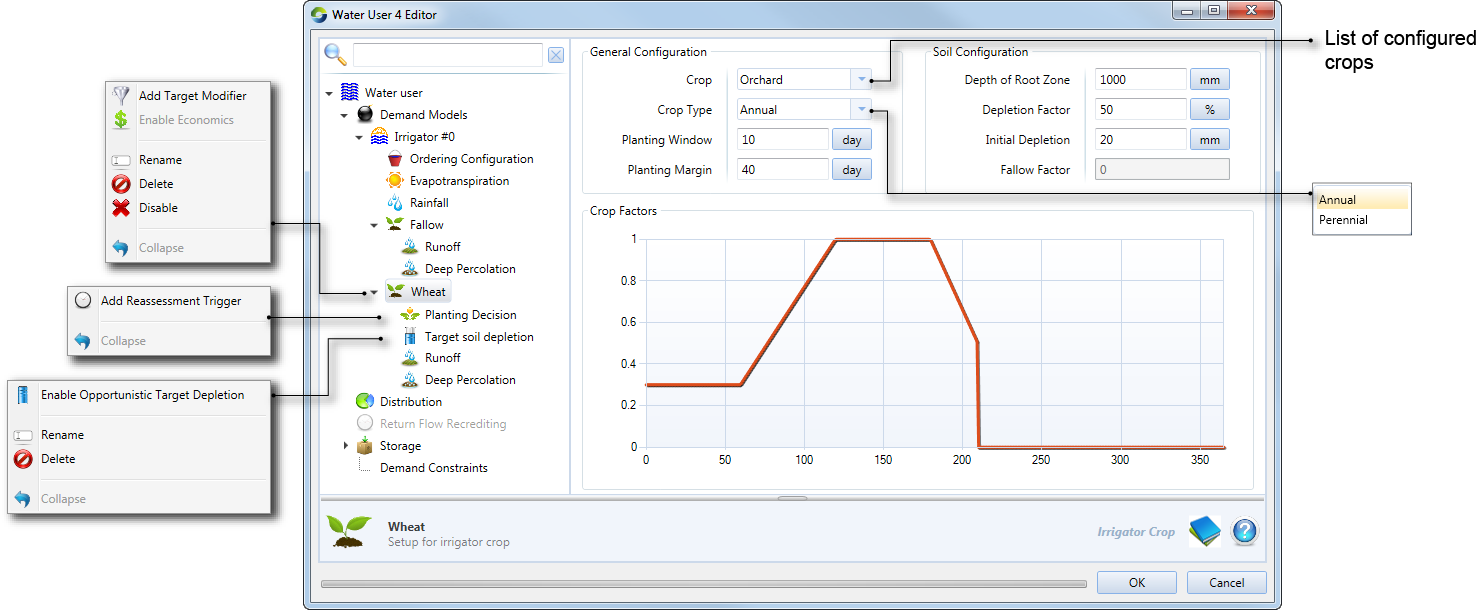
Planting Decision
Planting decisions are represented as a trigger in the Irrigator Demand Model and include a decision type, plant date, optional harvest date and an under irrigation factor. The number and size of cropped areas changes over time in response to planting decision triggers and available water.
Figure 5. Irrigator demand model (Planting Decision)
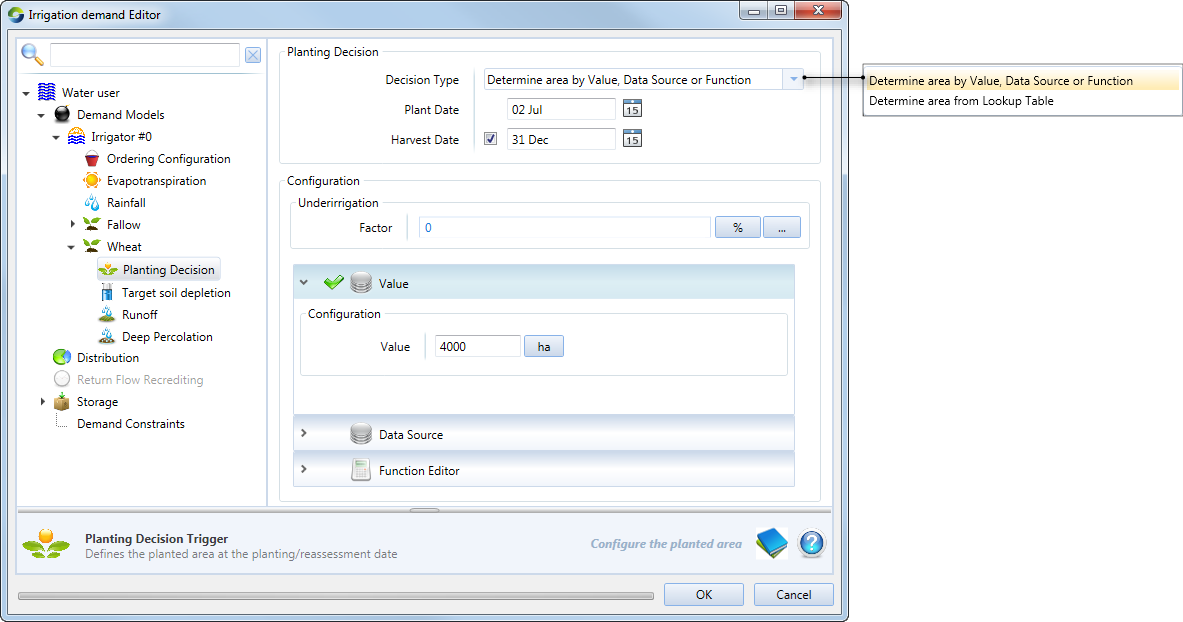
If Lookup Table is choosen as the Decision Type, you must define a configuration table (as shown in Figure 6), which can be entered manually or imported using the Import button. This table is used to determine the Area and Underirrigation Factor for a given value of Available Water. Additionally, for values of Available Water that are not present in the table, linear interpolation is used to determine the other two parameters. For the example shown in Figure 6, if available resources in a RAS are 15000ML, the planting area will be 3000ML based on linear interpolation between (10000, 2000) and (20000, 4000). The available resources from water user (order debit type) is determined from the current account balances plus on farm storage available water, as at maximum travel time, released water in the river is zero.
Planting decisions are made based on the travel time in advance of the Plant Date. If a Lookup table is used, Available Water is actually the travel time before the Plant Date. For example, if the plant date is 1 OCtober, and max travel time to the supply point (ie, travel time to storage farthest away), decision date is 10 days before 1 October. The Crop area is based on water available at 10 days before 1 October.
Figure 6. Irrigation demand model (Planting Decision, Lookup table)
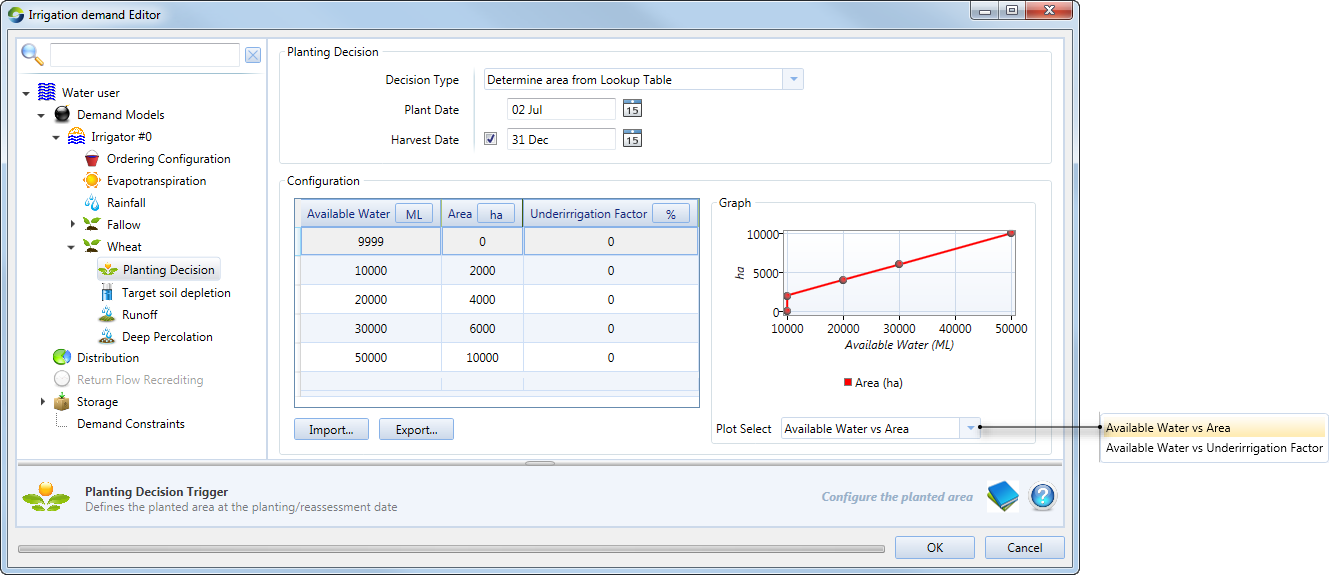
Target soil depletion
The amount of water in the rootzone is defined in terms of rootzone depletion, which describes the soil water deficit of the rootzone relative to field capacity. The target depletion can be specified as a time series, a pattern or as an expression.
Two target depletions can be specified (as shown in Figure 5):
- A Regulated Target - the target at which Irrigators water and attempts to maintain soil depletion; or
- An Opportunistic Target - used to generate opportunistic requests.
Runoff
This specifies the percentage of applied irrigation and rainfall that becomes deep percolation and drains below the rootzone. The Return Efficiency parameter is used to maximise return flow set efficiency to 100. You must also specify a return efficiency, which means that the proportion of runoff that is returned to the water user, which can be stored in the farm storage or returned to the river. The configuration window is similar to that shown in Figure 7.
Deep Percolation
The Spill From System parameter defines the amount of applied irrigation water that becomes runoff. A value of 0 results in no irrigation runoff; 10% indicates that 10% of the applied irrigation water becomes runoff. By default, both are set to 0 and do not need to be configured. The configuration window is shown in Figure 7.
A 10% supply escape efficiency would indicate that 10% of the applied water becomes runoff.
Figure 7. Irrigator demand model (Deep Percolation)
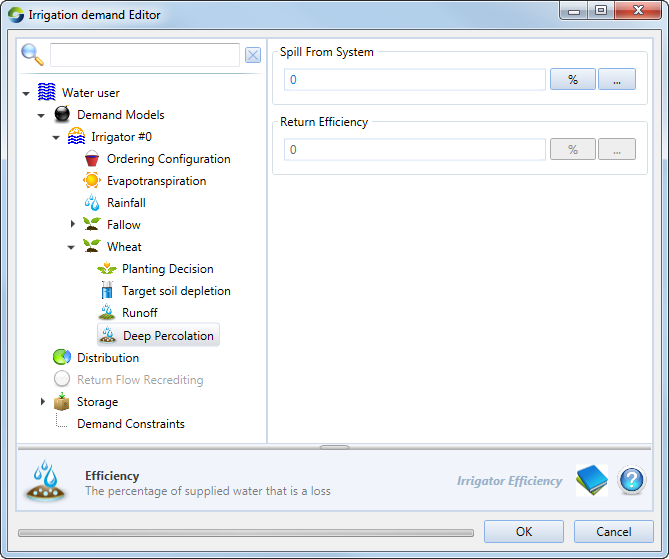
Economics
You can configure some simple economic considerations in Irrigator, as shown in Figure 8. To enable economic values to be configured for a crop, right click on the crop and choose Enable Economics. A simple, linear crop water production function is used to predict the reduction in crop yield resulting from water stress. Irrigator records the relative yield as a daily time series. The following parameters must be specified as an expression:
- Yield factor - represents the Yield response factor, as expressed in equation 90 of FAO56. This parameter defines how yield is reduced as a result of water stress. It is used in the calculation of the relative yield daily time series (one of the outputs of the demand model). Note that in Irrigation, the yield response factor is entered as a percentage rather than as a fraction;
- Expected Usage - this is a depth measured in mm (note that 100mm is equivalent to 1ML/ha); and
- Productivity - allows you to multiply the relative yield by a productivity term (eg. $/ha or tonnes/ha) to calculate socio-economic outputs.
For more information consult the Irrigator Demand Model page of the Source Scientific Reference Guide.
Figure 8 - Irrigation demand model (Crop Economics)
